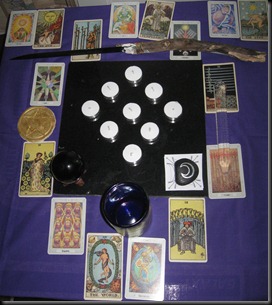We must never forget that there is more to magic than the mere performance of rites. One does not simply chant words of power and bend the world to one’s will. One is also bent, sometimes against our natural grain.
This post explores an intersection of sex and magic. There are no “gory details”, but if the thought makes you uncomfortable you might not want to read it. You have been warned. With that said, though, I hope that even if some of the people who know me out in the world choose not to read this one, it might receive particular scrutiny from any of my readers who have more experience in these areas than I.
Because this shit was so totally not in the manual.
I have now performed the Lesser Banishing Ritual of the Pentagram nearly every morning for three weeks. Magically speaking, this was a fantastic exercise: the energetic equivalent of a daily trip to the gym. The ritual got me out the door on several mornings when I thought I might not manage to leave the house.
Not all, however, was as it should be. The first sign that something was awry came at the Dark Moon, when a nymph with whom I have been keeping company invited me to share her sheets … and I failed to adequately reciprocate that honor. It’s embarrassing, but also a sad fact of male biology: sometimes the plumbing just doesn’t work, especially when one is nervous, as one might be with a new, younger lover.
Then, a week later, I failed again. I began to wonder what was different – my diet has changed, but not so much or so badly as to cause that sort of problem; I haven’t been that sleep deprived; I’m in as good a shape now, physically, as I’ve been in years; and it sure wasn’t lack of interest. Meditating on the subject, I could only find one significant difference: the magic I’m practicing.
Meditating further on the subject – perhaps the first serious self-diagnosis I’ve done since escalating from the Q-Cross to the LBRP – I discovered that in the formation of a Malkuth-shaped energy nexus at my feet, my “root” chakra (the one between my genitals and the base of my spine) and my One Point (the one right above that) had been hollowed out.
Was I doing the LBRP wrong? I don’t think so. Was I damaged by banishing elemental earth and invoking sexless archangels every morning? I think that might be it. Actually, given what came next, I know it was.
Three days ago, I replaced the archangelic invocations with invocations of the elements. I did traditional chakra meditations. I could feel it revitalizing me, but it wasn’t enough. Last night, I begged Dionysos for help with the immediate problem and sought answers in the underworld.
I found myself in a primordial garden, Dionysos’ white leopard and my side. The cat led me into the garden, warned me against the very very tempting apples, and gave me a krater of wine to carry as a gift. I struggled to keep up as the leopard led me through a series of veils which reminded me of nothing so much as the oppressive geometry which pinned me to the ground on my second underworld journey. It was a battle to maintain my shape – I was a man at the beginning, then the woman-shape I take sometimes in the underworld, then both, then the scarlet dragon I see sometimes in my visions of “past lives”, then a skeleton, then a sphere of white light, before finally managing to maintain my own form.
I caught up to the leopard at the steps of a great open-air temple – something drawing influence from Hellenic architecture, and the pagoda, and the most modern syncretism. I ascended the stairs and found a regal, queenly figure whom I know well. Usually she is nude and gargantuan, reclining in a cave within the bowels of the earth. Here she was only a little taller than myself, clothed in a rich and conservative chiton and a crown which resembled nothing so much as a castle.
“Only mortals are naked here,” she told me when I asked.
I gave her the goblet I had been given, and she drank of it before instructing me to do the same. We passed it back and forth, and when it was empty I knelt and her feet and laid my head on her knee. She told me that the Banishing Ritual was, indeed, to blame for my … problem: an incompatibility between the rite and my own Work. She repaired most of the damage that had been done to me, and told me that when I returned to this place on the first night of the Full Moon, she – or her representative – would instruct me in the proper way for me to perform the rite.
I returned to my flesh, cast back by that same geometric force. One hesitates to say more, for fear of being crude; suffice to say that my satyr’s honor has been restored.
Could anyone have warned me that this might happen? Possibly. Does anyone out there have an explanation for this shit? Sweet gods of fragrant heaven, I hope so. Chiefly, though, I share this story in hope that someone out there might be saved from this problem.
Also, I’m really glad that my gods love me enough to help with this sort of problem.


